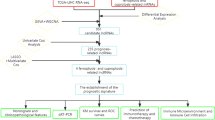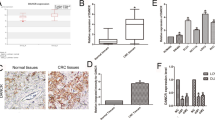Abstract
LncRNA has provided an important new perspective regarding gene regulation. Both the expression and activation of EGFR have been proven to be under the tight control of the GHR pathway. EGFR-AS1 has been found to inhibit the expression of EGFR. GHR-siRNA and EGFR-AS1-siRNA were transfected into HCC cell lines, and a series of WB, q-PCR, and IF experiments was conducted to evaluate whether EGFR-AS1 participated in the regulation of GHR and EGFR. We found that impeded expression of GHR decreased the expression of EGFR and EGFR-AS1 in vivo and in vitro. Then, it was verified that EGFR and EGFR-AS1 were relatively upregulated in HCC tissue, and they were significantly related to some clinical characteristics and patient prognosis. Furthermore, EGFR-AS1 was determined to promote HCC development by improving the ability of invasion and proliferation of HCC cells in vitro, and it was also found to affect the cell cycle. Our study identified that EGFR-AS1 may promote HCC genesis and development. EGFR-AS1 may act as a prognostic factor in HCC. More importantly, we observed that the inhibition of EGFR-AS1 in HCC cells significantly impeded cell proliferation and invasion in vivo, which might provide a potential possibility for targeted therapy of HCC.








Similar content being viewed by others
References
Verslype C. Hepatocellular carcinoma: ESMO–ESDO clinical practice guidelines for diagnosis, treatment and follow-up. Annals of Oncology. 2012;23(Supplement 7):vii41–8.
Buckley AF, Burgart LJ, Sahai V, Kakar S. Epidermal growth factor receptor expression and gene copy number in conventional hepatocellular carcinoma. Am J Clin Pathol. 2008;129:245–51.
Gozalez L et al. GH modulates hepatic epidermal growth factor signaling in the mouse. J Endorin. 2010;204:299–309.
Zerrad-Saadi A et al. GH receptor plays a major role in liver regeneration through the control of EGFR and ERK1/2 activation. Endocrinology. 2011;152(7):2731–41.
Lanning NJ, Carter-Su C. Recent advances in growth hormone signaling. Rev Endocr Metab Disord. 2007;7:225–35.
Brooks AJ, Wooh JW, Tunny KA, Waters MJ. Growth hormone receptor; mechanism of action. Int J Biochem Cell Biology. 2008;40:1984–9.
Barclay JL et al. In vivo targeting of the growth hormone receptor (GHR) Box1 sequence demonstrates that the GHR does not signal exclusively through JAK2. Mol Endocrinol. 2010;24:204–17.
Huang Y et al. Growth hormone-induced phosphorylation of epidermal growth factor (EGF) receptor in 3T3-F442A cells. Modulation of EGF-induced trafficking and signaling. J Biological Chem. 2007;278:18902–13.
Miquet JG et al. Transgenic mice overexpressing GH exhibit hepatic upregulation of GH-signaling mediators involved in cell proliferation. J Endocrin. 2008;198:317–30.
Takahashi K et al. Long noncoding RNA in liver diseases. Hepatology. 2014;60(2):744–53.
Braconi C et al. Expression and functional role of a transcribed noncoding RNA with an ultraconserved element in hepatocellular carcinoma. Proc Natl Acad Sci USA. 2011;108:786–91.
Kogure T et al. Extracellular vesicle mediated transfer of a novel long noncoding RNA TUC339: a mechanism of intercellular signaling in human hepatocellular cancer. Genes and Cancer. 2013;4:261–72.
Petch AK et al. Messenger RNA expression profiling of genes involved in epidermal growth factor receptor signalling in human cancer cells treated with scanning array-designed antisense oligonucleotides. Biochem Pharmacol. 2003;66(5):819–30.
Hu G, Lou Z, Gupta M. The long non-coding RNA GAS5 cooperates with the eukaryotic translation initiation factor 4E to regulate c-Myc translation. PLoS One. 2014;9(9):e107016. doi:10.1371/journal.pone.0107016.
Qiao HP et al. Long non-coding RNA GAS5 functions as a tumor suppressor in renal cell carcinoma. Asian Pac J Cancer Prev. 2013;14:1077–82.
Lu X et al. Downregulation of gas5 increases pancreatic cancer cell proliferation by regulating CDK6. Cell Tissue Res. 2013;354:891–6.
Liu Z et al. Downregulation of GAS5 promotes bladder cancer cell proliferation, partly by regulating CDK6. PLoS One. 2013;8:e73991.
He E et al. Fractionated ionizing radiation promotes epithelial-mesenchymal transition in human esophageal cancer cells through PTEN deficiency-mediated Akt activation. PLoS One. 2015;10(5):e0126149. doi:10.1371/journal.pone.0126149.
Hassan H, Greve B, Pavao MS, Kiesel L, Ibrahim SA, Gotte M. Syndecan-1 modulates beta-integrin-dependent and interleukin-6-dependent functions in breast cancer cell adhesion, migration, and resistance to irradiation. FEBS J. 2013;280(10):2216–27. doi:10.1111/febs.12111.
Theys J, Jutten B, Habets R, Paesmans K, Groot AJ, Lambin P, et al. E-cadherin loss associated with EMT promotes radioresistance in human tumor cells. Radiother Oncol. 2011;99(3):392–7. doi:10.1016/j.radonc.2011.05.044S0167-8140(11)00237-4.
Polyak K, Weinberg RA. Transitions between epithelial and mesenchymal states: acquisition of malignant and stem cell traits. Nat Rev Cancer. 2009;9(4):265–73. doi:10.1038/nrc2620nrc2620.
Kalluri R, Weinberg RA. The basics of epithelial-mesenchymal transition. J Clin Invest. 2009;119(6):1420–8. doi:10.1172/JCI3910439104.
Acknowledgments
We thank Prof. Wanyu’s generosity, which allowed our study to be conducted smoothly. This work was supported by the National Natural Science Foundation of China (No. 81172349 and No. 81272692).
Conflicts of interest
None
Author information
Authors and Affiliations
Corresponding author
Additional information
All authors have contributed equally to this manuscript.
Rights and permissions
About this article
Cite this article
Qi, Hl., Li, Cs., Qian, Cw. et al. The long noncoding RNA, EGFR-AS1, a target of GHR, increases the expression of EGFR in hepatocellular carcinoma. Tumor Biol. 37, 1079–1089 (2016). https://doi.org/10.1007/s13277-015-3887-z
Received:
Accepted:
Published:
Issue Date:
DOI: https://doi.org/10.1007/s13277-015-3887-z




